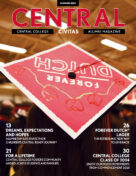 One of the coolest things about Superman is his X-ray vision, allowing him to see through solid materials. But did you know there’s a real-life version of “X-ray vision?” It’s called crystallography, and Marvin Hackert ’66 is one of the world’s leading authorities on the subject.
One of the coolest things about Superman is his X-ray vision, allowing him to see through solid materials. But did you know there’s a real-life version of “X-ray vision?” It’s called crystallography, and Marvin Hackert ’66 is one of the world’s leading authorities on the subject.
Crystallography is all about looking inside things to determine their basic structure. “X-ray crystallography enables one to ‘see’ molecules — nature’s building blocks,” Hackert says. “It is because X-rays have short wavelengths that are similar in size to the spacing between atoms in molecules that we can see atomic detail.”
Hackert explains how it works: “When an ordered array of a pure substance (a salt, drug, virus or protein) is made into a crystal and is then irradiated with X-rays, the atoms in the molecule interact with the X-rays. This interaction gives rise to diffraction and interference of those waves that become the data in the diffraction pattern that can be analyzed by the X-ray crystallographer to recreate the arrangement of atoms within the molecule. Unfortunately, we do not have a lens that works for X-rays, so it takes the skill of a trained crystallographer to determine or ‘see’ the resulting structures.”
Hackert is the William Shive Centennial Professor of Biochemistry at the University of Texas at Austin, as well as associate dean of graduate studies and director of faculty development and fellowship programs. In August he was elected president of the International Union of Crystallography (IUCr), serving during an exciting time for the organization — the celebration of 2014 as the International Year of Crystallography.
The celebration included a variety of events around the world, including outreach and educational programs. Hackert says, “In the United States we helped organize workshops for K-12 teachers and developed a ‘Crystallography World of Wonder’ kit to help school children learn about the properties of crystals and symmetry.”
Crystallography impacts day-to-day life in many ways, though most people are unaware. One example is pharmaceuticals. “If the crystallographer can see how a lead drug compound binds to its target, that information can guide the changes needed by chemists to synthesize a modified drug that may be a thousand, or million, times more effective,” Hackert says. “This in turn will mean that the drug will cost less and there will be fewer unwanted side effects, since far less of the drug is needed to be effective.”
Hackert was one of just three chemistry majors the year he graduated from Central, but today it is a popular major. Hackert says the field is full of wonder and discovery.
“To be the first person ever to see one of nature’s molecules, and then understand how it functions, in light of knowing its structure, is very rewarding,” he says. “And to be part of a large, worldwide community of scientists who share this love of the beauty of nature — and a common interest in understanding the properties and function of all types of materials — is like being part of a team with an international perspective.”












To encourage serious, intellectual discourse on Civitas, please include your first and last name when commenting. Anonymous comments will be removed.
Comments are closed.